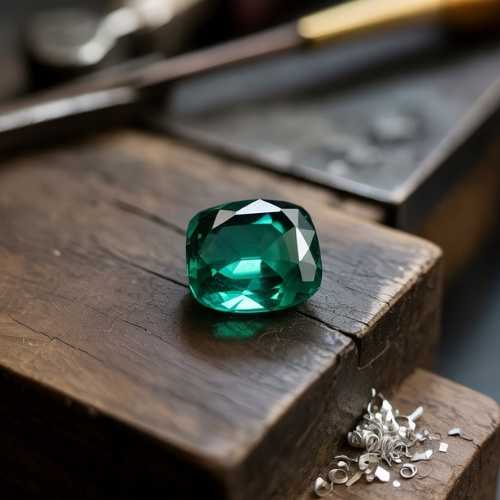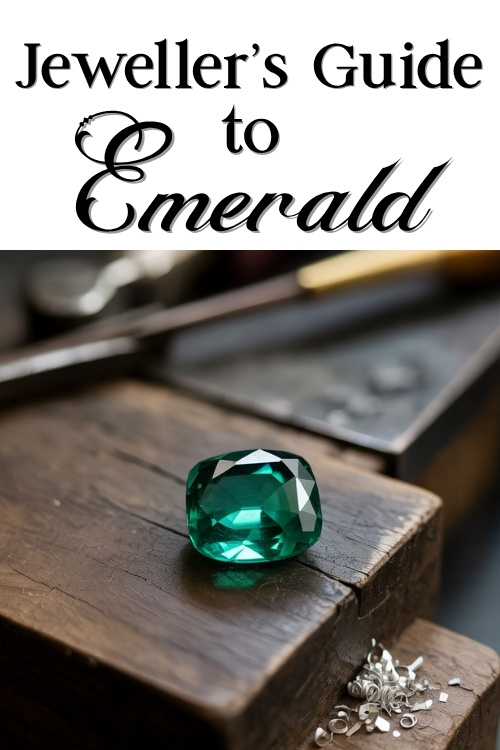Estimated reading time: 4 minutes
Emerald has long captured hearts with its deep, luxurious green, a hue so rich it’s become a colour in its own right. Velvety, vivid, and full of life, this timeless gem has adorned the crowns of royalty and the sketches of modern designers alike. Whether you’re working with a vintage-inspired setting or something sleek and contemporary, emerald brings a sense of quiet opulence to any piece.
Jump to:
Basic Identification Information
Name & Synonyms
Emerald; sometimes referred to as green beryl.
Species
Beryl
Colour Range
Light to deep green, typically with bluish or yellowish undertones.
Refractive Index
1.565–1.602
Birefringence
0.005–0.009
Optical Sign
Uniaxial –
Pleochroism
Moderate to Strong and 2 colours
bluish green and yellowish green
Specific Gravity
2.67–2.78
Fluorescence
Usually none, but sometimes a weak red glow
Lustre
Vitreous – glass-like shine when polished
Clarity
Type III
Nearly always included. This is an accepted part of the gem’s character.
Gems Often Mistaken For
Green tourmaline, Peridot
Mohs Hardness
7.5–8
Wearability
Good — suitable for most jewellery, but requires care due to internal inclusions.
Spotting Synthetic (Lab-Grown) Emerald
Lab-grown emeralds have the same chemical and physical properties as natural ones, which can make visual identification challenging. The easiest synthetics to spot are those that appear unusually clean as emeralds without any inclusions are extremely rare in nature.
When inclusions are present, their type can help indicate the gem’s origin. Magnification is essential. Natural emeralds typically show jagged, garden-like inclusions, while synthetic emeralds may display triangular metallic platelets, undissolved flux, or nail-head spicule inclusions, depending on the growth method.
Common Treatments
Most emeralds are treated to improve clarity. The most traditional method is oiling, often with cedarwood oil, which fills surface-reaching fractures and improves transparency. This enhancement is generally accepted in the industry but should still be disclosed.
Some modern stones are treated with resins or polymers instead of oil. Occasionally, these may be dyed green, though this is considered a less stable and lower-value treatment. Heat and harsh chemicals can compromise these enhancements, so full disclosure and care are essential.
Oiling is not permanent; it may need to be reapplied every few years, especially if the stone is worn frequently.
Durability & Setting Considerations
Despite their relatively high hardness, emeralds are considered brittle due to internal inclusions and fracture-prone areas. This makes them more vulnerable to chipping or breakage under impact.
For jewellers, protective settings such as bezels, halos, or sturdy prongs are highly recommended. Emerald cuts, with their step facets and rectangular shape, are a popular choice, helping to reduce stress on the stone while showcasing its rich colour.
Avoid exposing emeralds to heat during jewellery repair or resizing. When possible, remove the stone before soldering or heating to prevent damage or disturbance to treatments.
🛍️ Explore our selection of pre-owned Emerald Gemstones for your next jewellery creation.
Care Instructions
Cleaning
Use only warm, soapy water and a soft cloth. Avoid ultrasonic or steam cleaners, which may worsen existing fractures or damage oil/resin treatments.
Storage
Store separately from harder gems like diamonds or sapphires to avoid scratching. Wrap in a soft cloth or keep in a fabric-lined box.
Daily Wear
Emeralds should be treated as occasion-friendly rather than everyday-wear stones in high-impact pieces, like rings. Avoid exposing them to household cleaners, perfumes, and extreme temperature changes.
Market & Ethical Notes
Colombia remains the most renowned source of top-quality emeralds, with the legendary Muzo, Chivor, and Coscuez mines producing stones of deep, pure green. Zambia is another major producer, offering emeralds with a slightly bluish tone and excellent clarity. Brazil, Afghanistan, and Ethiopia also contribute to the global supply.
Due to emerald’s long history of treatment, ethical buying includes full disclosure of enhancements. Responsible sourcing practices are gaining traction, with more suppliers investing in traceability and better mining conditions. As always, transparency is key.
🔗 Learn more about the ethical and environmental story behind Reclaimed and Recycled Gemstones.
Symbolic & Spiritual Meanings
Emerald has long been considered a stone of renewal, growth, and insight. Sometimes known as the “stone of successful love,” it’s said to open the heart, restore emotional balance, and foster loyalty and compassion.
It’s also linked to the heart chakra, promoting openness, healing, and emotional connection.
🔗 Dive deeper into Emerald’s Symbolic & Spiritual Meanings
Etymology
The name emerald traces its roots through a linguistic journey. It began with the Greek word smaragdos, meaning “green gem,” which evolved into Latin’s smaragdus, then Old French’s esmeralde, before becoming emerald in Middle English.
🔗Curious about how emerald was viewed in ancient cultures? Explore its fascinating myths and legends
📌 Save this jeweller’s guide to emerald for quick reference next time you’re working with this stunning gem.


